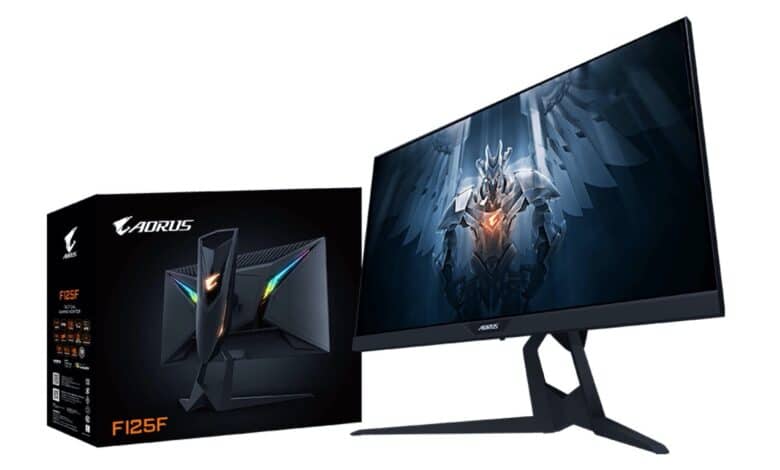
With the Aorus FI25F manufacturer Gigabyte seems to fulfill the dream of many gamers. After all, the monitor is not only supposed to offer special SuperSpeed IPS, but also comes along with a very fast reaction time of just 0.4 ms.
SuperSpeed IPS celebrates premiere
Gigabyte emphasizes not without reason that the upcoming Aorus FI25F offers so-called “SuperSpeed IPS”. After all, this makes the monitor the very first on the market. But what exactly is SuperSpeed IPS? This is a special IPS display that offers an impressive 240 Hz. The high hertz number is complemented by an amazingly short Moving Picture Response Time (MPRT). This is just 0.4 ms. Usually, 1 ms is already a very good value for gaming monitors.
Confusing designations for specs
Unfortunately, it has become fashionable for every manufacturer to use different parameters when describing their technical details. This starts with the panel itself. IPS displays, which are specifically designed to achieve high refresh rates, often get special terms. While Gigabyte calls the panel of its Aorus FI25F “SuperSpeed IPS”, Asus, for example, uses the term “Fast IPS”. Behind these designations, there are usually always racy fast IPS panels. So the different terms have more of a marketing purpose than a deeper meaning.
But it gets really confusing when you take a look at the reaction times. Manufacturer Asus uses the so-called Grey to Grey (GtG) response time for its specification. This is usually 1 ms for Asus monitors. Gigabyte, on the other hand, specifies its reaction time of 0.4 ms based on the MPRT, which is now commonly used. Unfortunately, you can’t directly compare the two times. The GtG value used by Asus has been used for many years to indicate the reaction time. Here we look at how long a pixel takes to change from one gray value to the next. In contrast, MPRT focuses on how long a pixel can be seen. Thus, the MPRT value is primarily an indication of whether or not there is annoying motion blur in the image. The lower the reaction time in this context, the sharper the picture is, even with fast moving images.
How does Gigabyte reach the 0.4 ms?
It’s amazing that manufacturer Gigabyte comes up with an amazing response time of just 0.4 ms on its Aorus FI25F. After all, the experts at TFT Central have calculated which refresh rate can provide which MPRT value. Classical LCD monitors without much frills usually have a refresh rate of 60 Hz. This means they offer an MPRT value of 16.67 ms. If an LCD monitor has a 120 Hz refresh rate, the response time is already 8.33 ms. If you continue the calculation with 240 Hz refresh rate, you arrive at 4.16 ms. For an MPRT value of 1 ms, you would need an IPS panel with at least 1,000 Hz. Such a high refresh rate is still a dream of the future. So how does the Aorus FI25F manage to achieve 0.4 ms?
Manufacturer Gigabyte relies on backlight strobing technology for its high-speed gaming monitor. With this trick the backlight of the monitor is switched on and off in quick changes. The end result is a large number of consecutive black images, which should ensure that the motion blur of the images is additionally reduced. As a result, the Aorus FI25F manages to achieve response times of less than 1 ms even without a gigantic frame rate. However, it is still puzzling how Gigabyte wants to reach the utopian value of 0.4 ms. In order to be able to finally verify this, the monitor must probably be subjected to an extensive test. Nevertheless, it becomes clear once again that good figures are primarily for marketing purposes and unfortunately far too often lead to confusion on the customer side.
Also the rest is quite impressive
But unfortunately, with all the debates about refresh rate and response time, the other technical details of the gaming monitor take a back seat. The 24.5-inch monitor comes with a resolution of 1,920 x 1,080 pixels. This corresponds to a contemporary Full HD resolution. In addition, the monitor should offer a color depth of 8 bits and cover 100% of the sRGB color space. It should also be able to score points for contrast. Thanks to a brightness of 400 cd/m², it achieves contrast values of 1,000:1. Gamers will be pleased that the Aorus FI25F meets the requirements for AMD FreeSync Premium and DisplayHDR 400. In terms of connections, the gaming monitor also sounds convincing. In addition to DisplayPort 1.2, two HDMI 2.0 ports, two USB 3.0 sockets and a headphone output are to be on board. Gigabyte also wants to score points in terms of ergonomics. The monitor can not only be swivelled horizontally and vertically, but also adjusted in height and tilt. RGB LEDs on the back provide that certain something. These can be easily controlled by software.
Price and availability
Unfortunately, manufacturer Gigabyte leaves us in the dark both with the price and the release of the promising gaming monitor. But as soon as we know more, we will inform you.








